Author: Thor Hartvigsen, On Chain Times Crypto Researcher; Translated by: Jinse Finance xiaozou
1. Preface
Since the launch of HYPE, Hyperliquid has achieved tremendous growth in both trading volume and revenue. HYPE was launched at a price of $2 on November 29th, and has since surged over 1400% in less than a month. This article will delve into the fundamentals of Hyperliquid and HYPE, discuss the bullish case for HYPE, and its potential valuation under the scenario of trading volume and revenue growth by 2025.
2. Trading Volume
Prior to the launch of HYPE, skeptics predicted that the trading volume after the airdrop would be low, as the past behavior of perpetual decentralized exchanges has shown that greedy capital would move from the highest reward protocol to the next highest reward protocol. Notably, since the launch of HYPE, Hyperliquid's trading volume has surged dramatically, setting a new single-day high of over $10 billion. In addition to the substantial incentives previously provided to traders, Hyperliquid is a high-quality on-chain product that is widely recognized by most users of the platform.
It is also worth noting that while the initial airdrop accounted for 31% of the HYPE supply, an estimated 42.81% of the total supply is expected to be used for future token distributions and community rewards. While some of these rewards may be specifically dedicated to staking incentives and potential rewards centered around the HyperEVM L1 ecosystem, the possibility of current HYPE holders receiving some form of reward unknowingly cannot be ruled out.
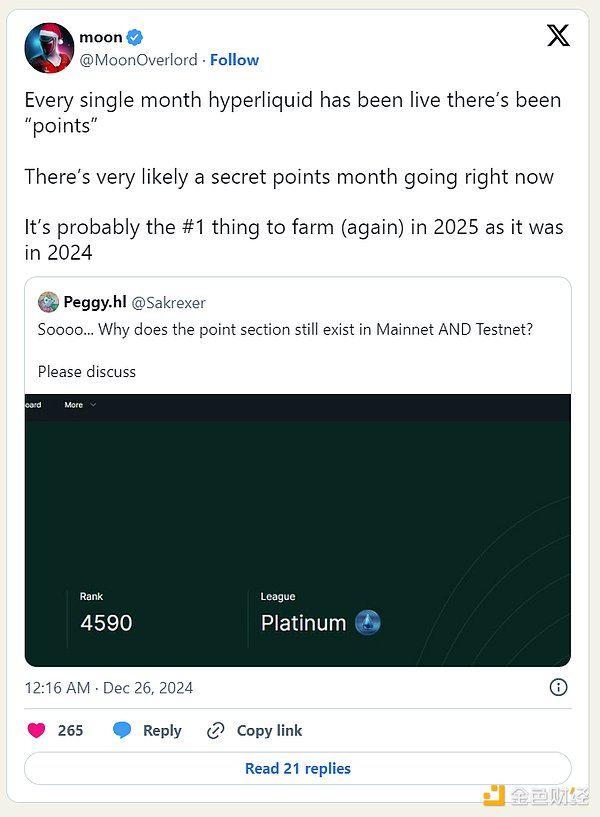
The 42.81% HYPE supply is equivalent to approximately $11 billion (at $25 per HYPE), which is a significant potential return, making Hyperliquid more attractive to perpetual contract traders. However, it is important to note that this is purely speculative.
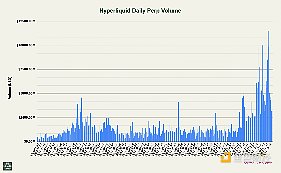
(1)Hyperliquid vs CEXs(Centralized Exchanges)
We have been tracking Hyperliquid's trading volume relative to centralized exchanges like Binance for some time. Over time, as more users and trading volume shift to the chain, Hyperliquid's market share will continue to grow. Comparing Hyperliquid to Binance, Hyperliquid still has a long way to go. However, Hyperliquid's market share has shown a clear upward trend in December, as shown in the chart below. Over the past two weeks, Hyperliquid's relative market share has been maintained at around 5-8%. According to Coingecko data, Binance's recent derivatives daily trading volume has been between $60 billion and $150 billion. However, as there is no way to actually verify these trading volume data from centralized exchanges, a degree of caution may be warranted.
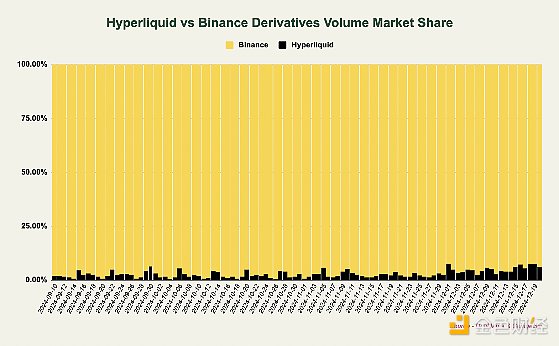
(2)Spot Trading Volume
You may already know that Hyperliquid also has a spot token market. Since the launch of HYPE, spot trading volume has increased significantly, with the largest trading volume tokens being HYPE, PURR, HFUN and PIP.
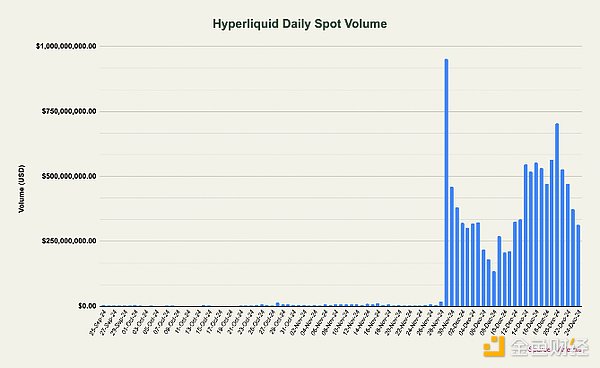
Tokens are added to the Hyperliquid spot market through auctions, with the highest bidder able to list their ticker. This occurs every 31 hours, with the current price being around $300,000, as shown in the image below. The highest auction price was for GOD on December 16th, with the bidder paying nearly $1 million.
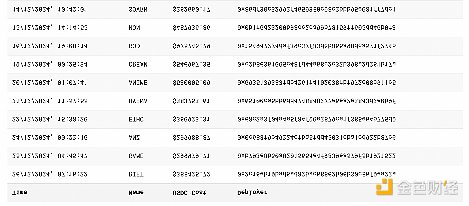
3. Fees and Revenues
(1)Perps(Perpetual Contracts)
Hyperliquid's fees are paid by the traders on the platform. Compared to other exchanges like Binance, the fees are maintained at a relatively low level to incentivize trading activity. For perpetual futures trading, the market order (taker) fee is 0.035% for most, and the limit order (maker) fee is 0.01%. The more you trade, the lower your fees.
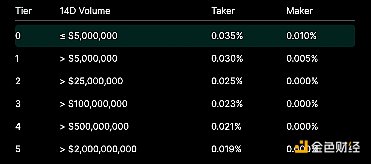
To calculate the fees collected by the protocol, the average fee paid by traders (considering the trading volume and average fee tiers of takers and makers) must be calculated. ASXN did a great analysis on this in their September report, as shown in the image below. This suggests an estimated average fee paid of 0.01276%, which is a conservative/worst-case assumption as it assumes market maker rebates.

Considering this average fee, if Hyperliquid's perpetual futures daily trading volume averages $5 billion to $10 billion, this would equate to $232,870,000 to $465,740,000 in annual fees (in fact, the actual fees may be higher due to the conservative assumption on average fees).
These fees are collected by the HLP market maker treasury, insurance fund, aid fund, and various other addresses on Hyperliquid. The team has not publicly disclosed the exact distribution of fee revenue from trading activity on the platform, making it difficult to accurately estimate HYPE buyback dynamics.
(2)Spot(Spot Trading)
Traders pay fees in the spot market to purchase and burn the traded tokens. Unsurprisingly, HYPE accounts for the majority of Hyperliquid's spot trading volume. So far, over 100,000 HYPE (worth $2.5 million at current prices) have been burned from HYPE's spot fees. From a macro perspective, this has not had a substantial impact on HYPE's supply (at least not yet) compared to the buybacks by the aid fund.
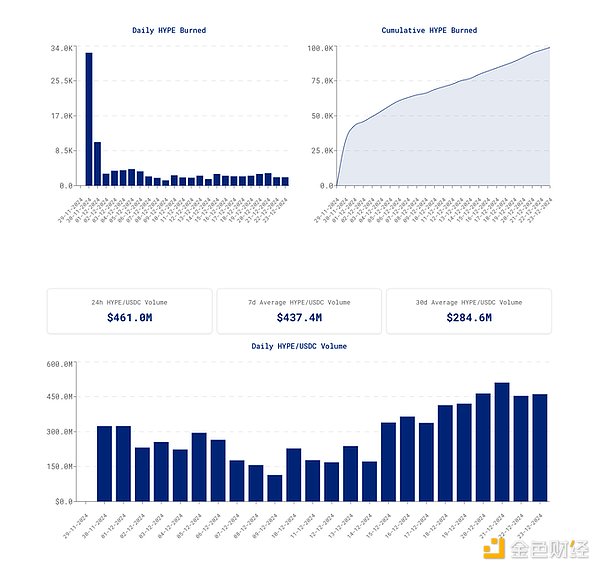
(3)Spot Auctions
Hyperliquid can also generate significant revenue from the funds paid by the winning bidders of the spot auctions. Assuming $300,000 per auction, Hyperliquid's annual revenue would increase by $84,774,000. Flo published an excellent analysis on X covering Hyperliquid's revenue under different spot auction prices and daily trading volume scenarios. Assuming $1 million per spot auction and $6 billion daily trading volume, Hyperliquid's estimated annual revenue is $829.5 million. At a 30x P/E ratio, this would value HYPE at $74.52 per token.
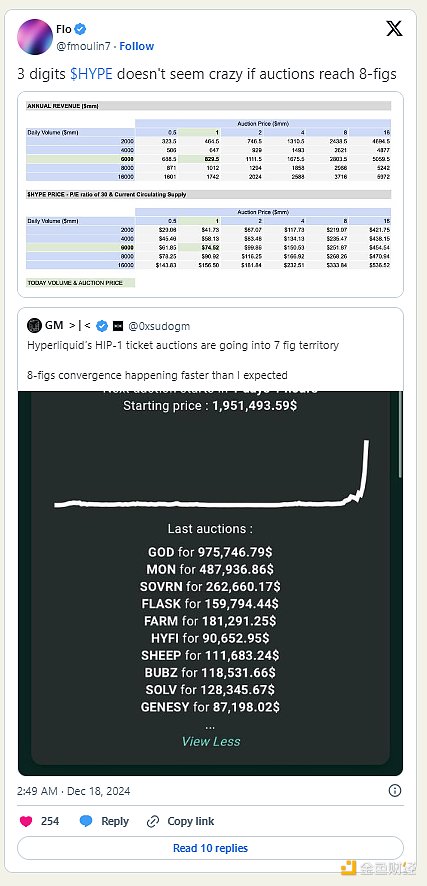
4. Aid Fund and HYPE Buybacks
While the exact distribution of revenue from spot auctions and perpetual trading between the Aid Fund (AF), Insurance Fund, HLP, and other addresses is currently unclear, we can gauge the daily HYPE buyback activity through the Aid Fund. A few days ago, I published an analysis on X covering the HYPE buybacks by the Aid Fund over a 48-hour period. At that time, 151,000 HYPE were bought back in 48 hours, equivalent to an annualized $686 million in buyback pressure. Over the past couple of days, Hyperliquid's daily trading volume has averaged $8 billion.
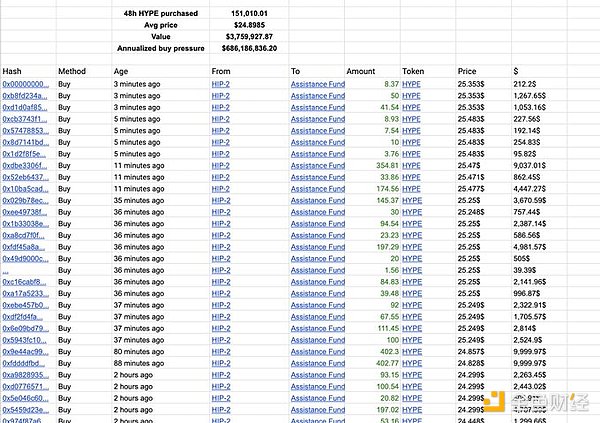
Compared to many other crypto protocols, HYPE directly captures value from the revenue generated by Hyperliquid.
5, Future Outlook
As we enter 2025, the bullish HYPE is a bet on the continued growth of trading volume on the Hyperliquid exchange and the growing demand for spot auctions, which will lead to increased revenue and further HYPE buybacks. One of the reasons Hyperliquid will be used by more and more people is that it has reserved billions of dollars in future rewards, making Hyperliquid a very profitable trading venue. Hyperliquid has a very strong user-centric community that has generated a lot of thought sharing and strong narratives around the protocol and HYPE.
With the emergence of new features such as staking, perpetual trading token margin, and the application ecosystem brought by HyperEVM, there will be many potential positive factors and many exciting things to look forward to.






